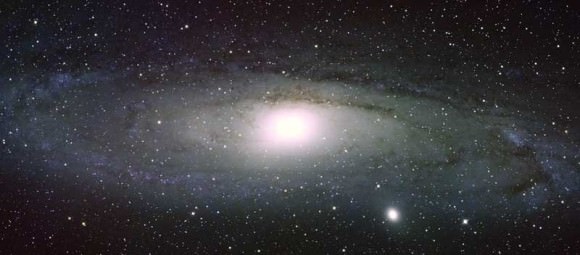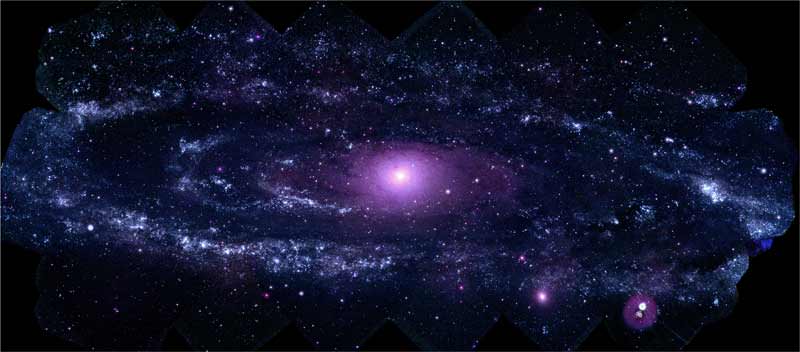[/caption]
Normally, the Swift satellite is searching for distant cosmic explosions. But recently it took some time to take a long look (total exposure time: 24 hours) with its ultraviolet eyes at the Andromeda galaxy, a.k.a. M31. The result is this gorgeous image. “Swift reveals about 20,000 ultraviolet sources in M31, especially hot, young stars and dense star clusters,” said Stefan Immler, a research scientist on the Swift team at NASA’s Goddard Space Flight Center. “Of particular importance is that we have covered the galaxy in three ultraviolet filters. That will let us study M31’s star-formation processes in much greater detail than previously possible.”
Compare this image to an optical version taken by a ground-based telescope:

M31, also known as the Andromeda Galaxy, is more than 220,000 light-years across and lies 2.5 million light-years away. On a clear, dark night, the galaxy is faintly visible as a misty patch to the naked eye.
Between May 25 and July 26, 2008, Swift’s Ultraviolet/Optical Telescope (UVOT) acquired 330 images of M31 at wavelengths of 192.8, 224.6, and 260 nanometers.
“Swift is surveying nearby galaxies like M31 so astronomers can better understand star- formation conditions and relate them to conditions in the distant galaxies where we see gamma-ray bursts occurring,” said Neil Gehrels, the mission’s principal investigator. Since Swift’s November 2005 launch, the satellite has detected more than 400 gamma-ray bursts — massive, far-off explosions likely associated with the births of black holes.
For more info on this image see this page from NASA. There’s also a podcast from Swift about this image, as well.


Compares favorably to this 2008 GALEX UV image: http://www.galex.caltech.edu/media/glx2008-01f_img01.html
When I was a snotty-nosed kid, back in 1969/70 when I became interested in astronomy after the Apollo 11 Moon landing, I was able to see with the naked eye the M31 galaxy as a misty patch, from my back yard here in London, UK; however, now I cannot see a bloody thing, even with 10 × 50 binoculars, because of the friggin’ light pollution — Aurora Londiniulis! 😐
What shall I say? Even in a very dark spot in the Eifel (Germany) is was barely detectable with the unaided eye – interestingly, it was better to detect if one wasn’t looking at the precise position. In the “Ruhrgebiet”, where I live, even a bigger scope is not really able to show it! The Milky Way is invisible all the time.
One more point on the to-do-list:
Go to a VERY dark spot on earth!
Probably that’s the reason why I stick more into theoretical works and why I actually go to bed at night 😀
I hear that the Australian outback is a good spot!
DrFlimmer, half the fun of astronomy is being up all night, reclining on a deckchair, eating a peanut-butter sandwich (none of that Nutella stuff for me!), washed down with strong, black coffee, while observing the night sky — whenever it’s bloody clear! 🙂
ERRATUM: “… eating a peanut-butter sandwich (none of that Nutella stuff for me!) washed down with strong, black coffee…” (without the comma before “washed”!)
That’s damn sexy.
@IVAN3MAN : I have spent some time out in the Australian Outback the view of the universe is unreal almost surreal.
The sky is so bright from all the visible stars the transition from night to very early morning is hardly noticeable.
Why is there so much UV at the centre of the galaxy? Is it generated by the black hole or is it just the density of the stars?
@ Ivan3man
The Atacama desert is supposed to be another good spot as I have heard somewhere 😉 .
In fact, in that desert is one reason why I could have chosen the “real” astronomer side: The “Astronomisches Institut der Ruhr-Universität Bochum” (AIRUB, astronomical institute of my university) has its “own” mountain down there with its own telescope!
A colleague of mine has been there recently for three weeks – I would have loved to go there, too, but for that I should have become a real astronomer. That was a tough decision 😉 .
Btw: It is the same colleague of mine who is working right now with the deepest observations from the Orion nebula EVER shot! He has found 200 (!!!!) accretion disks and Herbig-Haro-objects so far……..
Never done this but I’ll try to link to a composite image of both the visual and UV of M31.
http://i828.photobucket.com/albums/zz209/Dannemanne/Swift_M31_VandUV.jpg
DanRoy, Thanks for that link to the composite image. That wasn’t available in the press release, so this gives me another view for my collection. You done good 🙂
A rather similar construction of the UV and optical picture was the APOD recently:
http://antwrp.gsfc.nasa.gov/apod/ap090917.html
@ Jon,
You’re welcome. Made it in photoshop in 10 minutes.